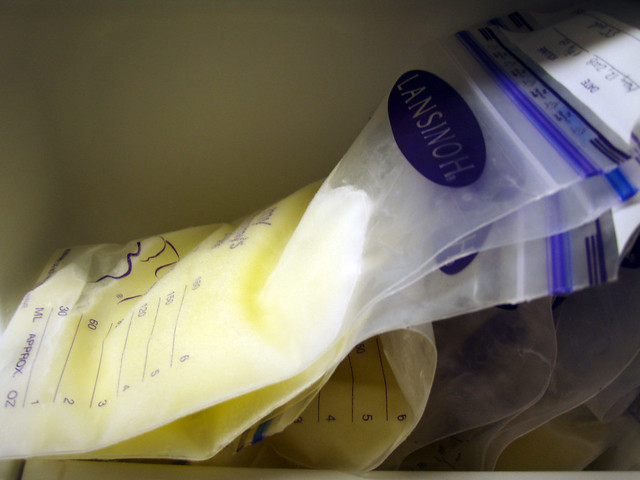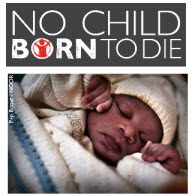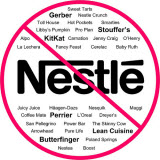Sunday
Nov282010
Risks of Informal Breastmilk Sharing versus Formula Feeding
 Sunday, November 28, 2010
Sunday, November 28, 2010
Anyone who has even thought about having a child recently has certainly had the "Breast is Best" message hammered into their brain. They have probably also heard countless tales of women who found breastfeeding difficult or impossible and have probably heard them say that infant formula is an acceptable alternative. While there is nothing wrong with those statements, there is a whole lot missing from the middle. What gets lost in the breast vs. formula debate is the option to use donor milk.
According to the World Health Organization's Global Strategy for Infant and Young Child Feeding (p.10):
The problem, for any baby that is not able to be exclusively breastfed by its own mother, is that there are risks to any alternate feeding method. In the absence of easily accessible and affordable breast milk from human milk banks, the determination of the best choice for those "individual circumstances" requires an assessment of the risks of various feeding methods that will never provide a clear and perfect answer.
 The Canadian Pediatric Association has called for the creation of more human milk banks in Canada and the Montreal Gazette has reported that Hema-Quebec (the blood collection agency) is looking into the possibility of establishing a human milk bank in Quebec. The United States has more human milk banks than Canada, but even there obtaining breast milk from a human milk bank can be difficult and expensive.
The Canadian Pediatric Association has called for the creation of more human milk banks in Canada and the Montreal Gazette has reported that Hema-Quebec (the blood collection agency) is looking into the possibility of establishing a human milk bank in Quebec. The United States has more human milk banks than Canada, but even there obtaining breast milk from a human milk bank can be difficult and expensive.
Until our governments and health care organizations make human milk banks a priority (like they do with blood), families whose babies need breastmilk (because they cannot tolerate formula) or whose babies would benefit from breastmilk (over formula) are left with no choice but to seek out informal milk sharing arrangements. In response to the growing demand for human milk, a number of informal milk sharing arrangements (e.g. Milkshare, HM4HB - Human Milk for Human Babies) have been established. They have gained a significant amount of profile recently through articles in the Montreal Gazette and Time magazine, among others. Health Canada has raised concerns about these arrangements and the Canadian Pediatric Association has said that it does not support the sharing of unprocessed milk.
However, at the same time, the government is making little progress in ensuring that women are able to feed their babies breastmilk. The government:
In short, the formula companies are not prevented from using unethical marketing practices, we need human milk banks but don't have them, and the government is ready to criticize parents rather than fixing the problem. So, as people lobby the government to fix this problem, mothers who are not able to exclusively breastfeed their babies are left with a difficult choice: informal milk sharing or infant formula. What are the benefits and risks of both?
The benefits of infant formula are:
The risks of infant formula include:
Some of the risks of using formula can occur even with just one bottle (e.g. gut closure which makes the baby more susceptible to bacteria and disease) and others occur only when a baby is exclusively formula fed. Or, put another way, every bit of breastmilk helps, but exclusive breastfeeding is required to gain the full range of benefits that come with breastfeeding. From that perspective, when a mom is unable to produce enough milk to exclusively breastfeed, it is understandable that the World Health Organization recommends using donor milk before considering formula.
For some babies, the risks of formula are more acute than others. Some infants are able to grow and develop on infant formula. However, some babies with failure to thrive, formula intolerance, allergies and other medical conditions may not be able to use formula at all. The fact that there is only one human milk bank in Canada is an even bigger injustice for those babies than for for the average baby that cannot access donor breastmilk.
The benefits of informal milk sharing are:
The risks of informal milk sharing include:
A lot of these risks can be significantly mitigated by screening the donor through interviews and blood tests. Human Milk 4 Human Babies has a series of suggestions on things you may wish to discuss with a potential donor in their FAQs (e.g. Recipients can ask donors to take blood tests or other health screenings).
The recipient parents will have to decide what they are willing to accept and not willing to accept from a donor. Some may be willing to accept a donor who smokes, has a glass of wine with dinner, and takes an Advil every once in a while. Others may decide that they are not willing to accept that. Some parents may decide they are only willing to accept donors they know personally because being able to trust the other person is important to them, whereas others may be willing to accept milk from a stranger if they have undergone certain screenings.
It is important to remember that both informal milk sharing and infant formula have risks. In both cases, some of the risks can be mitigated, but they cannot be entirely eliminated. The difference between the two is that:
Which risks are you more willing to accept -- those that come with infant formula or those that come with donor breastmilk? How much work are you willing to do in order to provide your baby with breastmilk? Those are questions that only you can answer. For some, those answers will come easily and for others the decision making process will be agonizingly difficult.
It shouldn't have to be this hard though. Something needs to be done about the availability of pasteurized donor milk in Canada, especially for at-risk babies and for short-term needs (e.g. a mom who is suffering from a short-term supply issue).
Image credit: Daquella manera on flickr
According to the World Health Organization's Global Strategy for Infant and Young Child Feeding (p.10):
For those few health situations where infants cannot, or should not, be breastfed, the choice of the best alternative – expressed breast milk from an infant’s own mother, breast milk from a healthy wet-nurse or a human-milk bank, or a breast-milk substitute fed with a cup, which is a safer method than a feeding bottle and teat – depends on individual circumstances. ...
...Infants who are not breastfed, for whatever reason, should receive special attention from the health and social welfare system since they constitute a risk group.
The problem, for any baby that is not able to be exclusively breastfed by its own mother, is that there are risks to any alternate feeding method. In the absence of easily accessible and affordable breast milk from human milk banks, the determination of the best choice for those "individual circumstances" requires an assessment of the risks of various feeding methods that will never provide a clear and perfect answer.
Lacking access to pasteurized human milk
 The Canadian Pediatric Association has called for the creation of more human milk banks in Canada and the Montreal Gazette has reported that Hema-Quebec (the blood collection agency) is looking into the possibility of establishing a human milk bank in Quebec. The United States has more human milk banks than Canada, but even there obtaining breast milk from a human milk bank can be difficult and expensive.
The Canadian Pediatric Association has called for the creation of more human milk banks in Canada and the Montreal Gazette has reported that Hema-Quebec (the blood collection agency) is looking into the possibility of establishing a human milk bank in Quebec. The United States has more human milk banks than Canada, but even there obtaining breast milk from a human milk bank can be difficult and expensive.Until our governments and health care organizations make human milk banks a priority (like they do with blood), families whose babies need breastmilk (because they cannot tolerate formula) or whose babies would benefit from breastmilk (over formula) are left with no choice but to seek out informal milk sharing arrangements. In response to the growing demand for human milk, a number of informal milk sharing arrangements (e.g. Milkshare, HM4HB - Human Milk for Human Babies) have been established. They have gained a significant amount of profile recently through articles in the Montreal Gazette and Time magazine, among others. Health Canada has raised concerns about these arrangements and the Canadian Pediatric Association has said that it does not support the sharing of unprocessed milk.
However, at the same time, the government is making little progress in ensuring that women are able to feed their babies breastmilk. The government:
- Does not appear to be making any moves towards establishing a strategy for human milk banks in Canada.
- Has signed but does not enforce the WHO Code of the Marketing of Breast-Milk Substitutes.
- Has admitted that it its attempts to stop infant formula manufacturers from using unproven or misleading claims have been ineffective.
In short, the formula companies are not prevented from using unethical marketing practices, we need human milk banks but don't have them, and the government is ready to criticize parents rather than fixing the problem. So, as people lobby the government to fix this problem, mothers who are not able to exclusively breastfeed their babies are left with a difficult choice: informal milk sharing or infant formula. What are the benefits and risks of both?
Infant Formula
The benefits of infant formula are:
- It is a regulated manufactured substance that must comply with certain standards.
- It is easily accessible in a wide variety of convenient retail locations (albeit at a cost that may not be affordable to many).
The risks of infant formula include:
- Babies are more susceptible to bacteria and disease (see "Just One Bottle Won't Hurt" -- Or Will It?).
- Higher risk of wide variety of health problems (see Scientific Benefits of Breastfeedingfor more details), such as:
- Middle ear infections
- Eczema
- Gastrointestinal infections
- Lower respiratory tract diseases
- Asthma
- Type 1 diabetes
- Type 2 diabetes
- Childhood leukemia
- Sudden infant death syndrome
- Possible contamination of infant formula during the manufacturing process (despite regulations that are in place), e.g.
- Substances sneaking into formula that should not be there, such as melamine or beetles.
- E.zakazakii infections, which can result in neonatal meningitis and has caused the death of infants, is considered to be significantly under-reported in all countries. E.zakazakii outbreaks linked to infant formula has been reported as causing deaths in infants in developed countries as recently as 2004 in France (see WHO's Guidelines in the Safe Preparation, Storage and Handling of Powdered Infant Formula - p.3).
- Salmonella outbreaks associated with infant formula have been recorded in Canada, France, Korea, Spain, the UK and the United States since 1995 (see WHO's Guidelines in the Safe Preparation, Storage and Handling of Powdered Infant Formula - p.3).
- Tampering with infant formula, such as the recent tampering with Nestle Good Start formula cans in Canada.
- Use of toxic chemicals such as BPA in the packaging for infant formula.
- In susceptible families, breastfed babies who are supplemented with formula can be sensitized to cow's milk protein, resulting in allergic reactions (see "Just One Bottle Won't Hurt" -- Or Will It?).
- Risks in the water that is used to prepare infant formula, including:
- Possible bacteria in the water (this risk can be minimized by boiling water).
- Flouride in municipal water systems, which can cause dental flourosis, may damage the developing brain, can act as an "endocrine disrupter" thereby disrupting thyroid function, and may be linked to bone cancer (see Flouride Warning for Infants).
- Contamination or bacteria growth due to improper preparation, storage and handling of infant formula (including not washing hands, not sterilizing bottles, etc).
Some of the risks of using formula can occur even with just one bottle (e.g. gut closure which makes the baby more susceptible to bacteria and disease) and others occur only when a baby is exclusively formula fed. Or, put another way, every bit of breastmilk helps, but exclusive breastfeeding is required to gain the full range of benefits that come with breastfeeding. From that perspective, when a mom is unable to produce enough milk to exclusively breastfeed, it is understandable that the World Health Organization recommends using donor milk before considering formula.
For some babies, the risks of formula are more acute than others. Some infants are able to grow and develop on infant formula. However, some babies with failure to thrive, formula intolerance, allergies and other medical conditions may not be able to use formula at all. The fact that there is only one human milk bank in Canada is an even bigger injustice for those babies than for for the average baby that cannot access donor breastmilk.
Informal Milk Sharing
The benefits of informal milk sharing are:
- Babies have access to human milk, which is designed by nature to meet their nutritional needs.
- Babies, especially those at risk, do not have to be exposed to the many risks of infant formula. This is especially beneficial in instances where the donor milk would be used on a temporary basis (e.g. as the mom builds her supply), thereby allowing her to avoid the risks that come from the introduction of a small amount of formula.
- Families save money by not having to purchase extremely expensive and difficult to obtain pasteurized milk or infant formula.
The risks of informal milk sharing include:
- Possible transmission of HIV via breastmilk. However:
- According to the CDC:
- The risk of HIV transmission from expressed breast milk consumed by another child is believed to be low because:
- In the United States, women who are HIV positive and aware of that fact are advised NOT to breastfeed their infants
- Chemicals present in breast milk act, together with time and cold temperatures, to destroy the HIV present in expressed breast milk
- Transmission of HIV from single breast milk exposure has never been documented
- The risk of HIV transmission from expressed breast milk consumed by another child is believed to be low because:
- According to research from the University of California:
- Babies that do not receive any formula have a much lower chance of contracting HIV from contaminated breastmilk than those who have received some formula.
- Flash heating can be used to kill the HIV in breastmilk.
- According to the CDC:
- Possible transmission of other sexually transmitted diseases:
- Prescription or over-the-counter drugs, alcohol or tobacco use by the donor:
- Most drugs are minimally excreted into breastmilk and many drugs are perfectly safe to take while breastfeeding.
- According to the Newman Breastfeeding Clinic and Institute "there are plenty of risks in not breastfeeding, so the question essentially boils down to: Does the addition of a small amount of medication to the mother’s milk make breastfeeding more hazardous than formula feeding? The answer is almost never. Breastfeeding with a little drug in the milk is almost always safer. In other words, being careful means continuing breastfeeding, not stopping." This is echoed by Health Canada. There are certainly some drugs that are unsafe, but generally women who are taking those drugs would not be breastfeeding and therefore not be in a place to be donating milk.
- Alcohol does pass into the breastmilk, but only in very small amounts. A woman would have to be very drunk while breastfeeding/pumping in order for it to create a risk to the infant. Small amounts of alcohol while breastfeeding is fine.
- Mothers who smoke are encouraged to quit during pregnancy and breastfeeding. However, smoking and breastfeeding is still better than smoking and formula feeding.
- Most drugs are minimally excreted into breastmilk and many drugs are perfectly safe to take while breastfeeding.
- Possible contamination of milk through improper storage or handling (similar to with formula, albeit with some different guidelines to follow).
A lot of these risks can be significantly mitigated by screening the donor through interviews and blood tests. Human Milk 4 Human Babies has a series of suggestions on things you may wish to discuss with a potential donor in their FAQs (e.g. Recipients can ask donors to take blood tests or other health screenings).
The recipient parents will have to decide what they are willing to accept and not willing to accept from a donor. Some may be willing to accept a donor who smokes, has a glass of wine with dinner, and takes an Advil every once in a while. Others may decide that they are not willing to accept that. Some parents may decide they are only willing to accept donors they know personally because being able to trust the other person is important to them, whereas others may be willing to accept milk from a stranger if they have undergone certain screenings.
Which is riskier? Informal human milk sharing or formula?
It is important to remember that both informal milk sharing and infant formula have risks. In both cases, some of the risks can be mitigated, but they cannot be entirely eliminated. The difference between the two is that:
- Many of the risks of human milk can be significantly decreased or eliminated through diligence on behalf of the donor and recipient.
- Many of the risks of infant formula are ever-present -- i.e. no amount of care or diligence by the formula companies or the parents will erase the health problems that can result from feeding formula.
Which risks are you more willing to accept -- those that come with infant formula or those that come with donor breastmilk? How much work are you willing to do in order to provide your baby with breastmilk? Those are questions that only you can answer. For some, those answers will come easily and for others the decision making process will be agonizingly difficult.
It shouldn't have to be this hard though. Something needs to be done about the availability of pasteurized donor milk in Canada, especially for at-risk babies and for short-term needs (e.g. a mom who is suffering from a short-term supply issue).
Image credit: Daquella manera on flickr




















Reader Comments (112)
[...] ¿es más peligrosa la leche humana de otra mujer que la artificial? ¿Se toman las suficientes medidas de seguridad en los intercambios? ¿Qué lleva a unas mujeres a [...]
As a result of milk sharing, primarily through HM4HBs, then by word of mouth as I've gotten to know people, we have been fortunate to keep our adopted baby on breastmilk for nearly the entire 7 months we've had him (except for the first few days while he was in the hospital - they wouldn't allow donor milk unless it came from a milk bank). I was very uncertain that we would make it to 6 months, my original goal, but we are well on our way to making it to a year, our new goal. I am so thankful of the milky mommas out there willing to share their milk and put in the extra time and effort it takes to pump and store the milk. In their honor, I did my part to try to induce lactation and am still pumping myself, but I've only ever been able to get an ounce during a pumping session despite all the herbs I've taken, however, I have been happy that I have been able to contribute to his nourishment. He is a very happy, healthy baby. Only 1 short-duration fever just recently and he's in the 50% percentile on all his measurements.
[...] The first myth is that informal milk sharing is riskier than infant formula. [...]
You'll enjoy my vision of a world where donor breastmilk is the default option, not formula...
http://minimalistmum.blogspot.com/2011/08/this-is-not-breastfeeding-blog.html
[...] that infant formula is safer than informal breastmilk sharing. Proponents of milk sharing note that the risks of infant formula are always present, while the risks of informal milk sharing can be miti... by taking appropriate precautions. The second myth is that breastmilk is a scarce [...]
[...] Risks of Informal Breastmilk Sharing versus Formula Feeding. Rate this: Share this:FacebookLike this:LikeBe the first to like this post. [...]
[...] positive. Milksharing also empowers recipient families because they can inform themselves of the risks and benefits of different types of supplemental feeding, and choose what works best for them. Direct woman to woman milk sharing involves no [...]
[...] in milk supply, or for adopted infants. PhD in Parenting wrote an excellent post comparing the risks of formula with the risks of human milk sharing, which is very comprehensive and makes the following accurate [...]
[...] third, do not tell me that your baby is just as well off as mine is, even though he’s being formula fed. Go get a life, and get an [...]
Hi Interesting article, thanks. You list type 1 Diabets as a risk of formula feeding. - just wondering if you could reference any research or links to back this up. Thanks.
Caorimhe Whelan-
A simple web search of formula feeding and diabetes will pull up a wealth of scholarly articles on the subject. Formula is nowhere close to replacing human breastmilk, regardless of what formula companies would like for you to think. Development of diabetes is only one risk associated with formula feeding. Breastmilk is incredibly beneficial to the child, and breastfeeding is very beneficial to the mother.
Here is a link to one to get you started: http://diabetes.diabetesjournals.org/content/48/7/1389.short
Caoimhe -- The reference is included if you click through. Here is a direct link to the meta-study: http://www.ncbi.nlm.nih.gov/books/NBK38333/#B106838
The conclusion:
"In conclusion, even though there is some evidence to suggest that breastfeeding for more than 3 months is associated with a reduced risk of type 1 diabetes, this evidence must be interpreted with caution because of the possibility of recall biases and suboptimal adjustments for potential confounders in the primary studies."